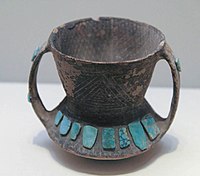| Geographical range | Gansu, China |
|---|---|
| Dates | 1900-1500 BCE. |
| Preceded by | Majiayao culture (2,300–2,000 BCE)[1] Qijia culture (2,200–1,600 BCE) Xichengyi culture (2,000–1,600 BCE)[1] |
| Followed by | Siwa culture (1350-650 BCE) Shanma culture (900–200 BCE)[1] |

The Siba culture (Chinese: 四坝文化), also called Huoshaogou culture (火烧沟), was a Bronze Age archaeological culture that flourished circa 1900 to 1500 BC in the Hexi Corridor, in Gansu Province of Northwest China. It was discovered in 1984 at Sibatan in Shandan County.[2] Siba type pottery vessels are different from the others in Gansu. Siba produced painted pottery with coloured decorations; these were painted after the vessels had been fired. Similar pottery was used by the Tianshanbeilu culture at Hami basin to the west.[citation needed]
Characteristics
[edit]The Siba engaged in agricultural activities like millet farming and pig farming.[citation needed] Their metallurgy was highly developed.[citation needed]
Siba culture is found mainly to the west of the Gansu corridor. The locations are found at Yongchang, Minyue, Jiuquan, Yumen counties, and others. Siba culture is bordered by the Qijia culture to the east. The later period of Qijia is very close to Siba culture. The Siba culture may have developed independently.[citation needed]
The site of Ganguya in Jiuquan has been excavated.[3]
Significant differences have been observed in the comparison of the burial customs and artifacts in the three sites excavated: Donghuishan, Huoshaogou and Ganguya.[4]
"During the first two periods of the [Donghuishan] Cemetery, there were only arsenical copper articles, but by the third period, bronze articles came into being. In the Ganguya Cemetery which was later than the Donghuishan Cemetery, more than sixty-five percent of the copper samples was tested bronze articles."[5]
Influences
[edit]Siba culture played an intermediary role between the cultures to the east and west. There were also contacts with the Eurasian steppe. Research indicates that there was close interaction between agricultural and pastoral/hunting communities in this wide geographical area; pastoral/hunting communities also possessed many metal artefacts.[6]
The cultures of West Asia and Central Asia spread eastward as early as the late Neolithic period and the early Bronze age, when bronze technology, pottery and ornamation styles were introduced to the early cultures of China, such as the Siba culture (about 2000-1600 BCE), the Qijia culture (2500-1500 BCE), the Chawuhugoukou culture (around 800-100 BCE) or the Subeshi culture (1100-100 BCE).[7]
Many of the artifacts of the Siba culture are thought to have derived from the Seima-Turbino culture of the Altai Mountains area.[8]
Artifacts
[edit]-
Bronze Qi axe, Siba Culture
-
Pottery jar inlaid with turquoise, Siba Culture, Gansu.
-
Gold earring, Siba culture, Gansu.
-
Bronze mace head with 4 ram heads, Siba Culture, 1900-1400 BC. Probably derived from the Seima-Turbino culture.[8]
-
Stone macehead, Siba culture. Probably derived from the Seima-Turbino culture.[8]
-
Bronze awl with bone handle.Probably derived from the Seima-Turbino culture.[8]
References
[edit]

- ^ a b c d e Li, Xin; Wei, Wenyu; Ma, Minmin; Lu, Minxia; Du, Linyao; Yang, Yishi; Chen, Guoke; Ren, Lele (2023). "Transformation of animal utilization strategies from the late Neolithic to the Han Dynasty in the Hexi Corridor, northwest China: Zooarchaeological and stable isotopic evidence". Frontiers in Earth Science. 10. Bibcode:2023FrEaS..1064803L. doi:10.3389/feart.2022.1064803. ISSN 2296-6463.
- ^ An Zhimin (1996), THE BRONZE AGE IN EASTERN PARTS OF CENTRAL ASIA. (PDF) Unesco.org
- ^ Report on the Archaeological Excavation of Ganguya Cemetery. Chinese Archaeology, 2016-10-25
- ^ Chen Xiao San (2012), Research on the Early Bronze Age Cultures in the Hexi Corridor and Surrounding Areas
- ^ Donghuishan Cemetery ncl.edu.tw
- ^ Li Liu, Xingcan Chen, The Archaeology of China: From the Late Paleolithic to the Early Bronze Age. Cambridge World Archaeology. Cambridge University Press, 2012 ISBN 0521643104 p336
- ^ Zhang, Kai (4 February 2021). "The Spread and Integration of Painted pottery Art along the Silk Road". Region - Educational Research and Reviews. 3 (1): 18. doi:10.32629/RERR.V3I1.242. S2CID 234007445.
In the late Neolithic period and the early Bronze age, pottery, ornamentation and bronze culture with the characteristics of West Asia and Central Asia were introduced into Xinjiang, including Qijia culture (2500-1500 BC), Siba culture (about 2000-1600 BC), Chawuhugoukou culture (around 800-100 BC), Turpan Subeixi culture (1100 bc-100 BC) and other cultures.
- ^ a b c d Lin, Meicun (2016). "Seima-Turbino Culture and the Proto-Silk Road". Chinese Cultural Relics. 3 (1–002): 249, Figure 9. ISSN 2330-5169.
- ^ Rawson, Jessica (2020). "Chariotry and Prone Burials: Reassessing Late Shang China's Relationship with Its Northern Neighbours". Journal of World Prehistory. 33 (2): 138–168. doi:10.1007/s10963-020-09142-4.
Further reading
[edit]- Jidong Yang, Siba: Bronze Age Culture of the Gansu Corridor. (PDF) Sino-Platonic Papers, 86 (October 1998)
- A Study on Donghuishan Cemetery— Including a Discussion on the Siba Culture and its Position in Sino-Western Cultural Exchange (A Summary) Zhang Zhongpei




![Bronze mace head with 4 ram heads, Siba Culture, 1900-1400 BC. Probably derived from the Seima-Turbino culture.[8]](http://upload.wikimedia.org/wikipedia/commons/thumb/9/97/Bronze_mace_head_with_4_sheep%2C_Siba_Culture%2C_1900-1400_BC.JPG/200px-Bronze_mace_head_with_4_sheep%2C_Siba_Culture%2C_1900-1400_BC.JPG)
![Stone macehead, Siba culture. Probably derived from the Seima-Turbino culture.[8]](http://upload.wikimedia.org/wikipedia/commons/thumb/b/ba/Siba_Culture_Stone_Mace_Head_%2810094266803%29.jpg/200px-Siba_Culture_Stone_Mace_Head_%2810094266803%29.jpg)
![Bronze awl with bone handle.Probably derived from the Seima-Turbino culture.[8]](http://upload.wikimedia.org/wikipedia/commons/thumb/0/08/Siba_Culture_Bronze_Awl_with_Bone_Handle_%2810094186235%29.jpg/200px-Siba_Culture_Bronze_Awl_with_Bone_Handle_%2810094186235%29.jpg)